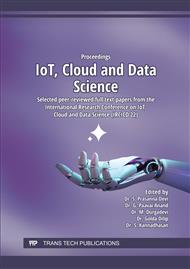[1]
Rao, P.S., Srinivas, K. and Mohan, A.K., 2020. A survey on stock market prediction using machine learning techniques. In ICDSMLA 2019 (pp.923-931). Springer, Singapore.
DOI: 10.1007/978-981-15-1420-3_101
Google Scholar
[2]
Challa, M.L., Malepati, V. & Kolusu, S.N.R. S&P BSE Sensex and S&P BSE IT return forecasting using ARIMA. Financ Innov 6, 47 (2020).
DOI: 10.1186/s40854-020-00201-5
Google Scholar
[3]
A Prediction Approach for Stock Market Validation Based on Time Series Data | IEEE Access | Sheikh Mohammad Idrees, M.Afshar Alam, Parul Agarwal.
DOI: 10.1109/access.2019.2895252
Google Scholar
[4]
The Performance of LSTM and BiLSTM Forecasting Time Series | IEEE International Conference of Big Data | Sima Siami-Namini, Neda Tavakoli, Akbar Siami Narmin.
DOI: 10.1109/bigdata47090.2019.9005997
Google Scholar
[5]
Financial time series forecasting with multi-modality graph neural network. | Elsevier | Daweu Cheng, Fangzhou Yang, Sheng Xiang, Jin Liu.
Google Scholar
[6]
Temporal Pattern Attention for multivariate time series forecasting | Springer | Shun-Yao Shih, FanKeng Sun, Hung-yi Lee.
Google Scholar
[7]
A CNN LSTM model for gold price time series forecasting | Springer | Ionnis E.Liveria, Emmanuel Pintelas, Panagiotis Pintelas.
DOI: 10.1007/s00521-020-04867-x
Google Scholar
[8]
Time Series Forecasting with Deep Learning: A Survey | The Royal Society | Byran Lim, Stefan Zohren.
Google Scholar
[9]
A hybrid method of exponential smoothing and recurrent neural networks for time series forecasting | Elsevier | Slawek Syml.
Google Scholar
[10]
Practical Time Series Analysis by Aileen Nielsen (O'Reilly). Copyright 2020 Aileen Nielsen, 978-1-492-04165-8.
Google Scholar
[11]
Banerjee, D., 2014, January. Forecasting of Indian stock market using time-series ARIMA model. In 2014 2nd international conference on business and information management (ICBIM) (pp.131-135). IEEE.
DOI: 10.1109/icbim.2014.6970973
Google Scholar
[12]
Merh, N., Saxena, V.P. and Pardasani, K.R., 2010. A comparison between hybrid approaches of ANN and ARIMA for Indian stock trend forecasting. Business Intelligence Journal, 3(2), pp.23-43.
Google Scholar
[13]
Jothimani, D. and Yadav, S.S., 2019. Stock trading decisions using ensemble-based forecasting models: a study of the Indian stock market. Journal of Banking and Financial Technology, 3(2), pp.113-129.
DOI: 10.1007/s42786-019-00009-7
Google Scholar
[14]
Jothimani, D. and Yadav, S.S., 2019. Stock trading decisions using ensemble-based forecasting models: a study of the Indian stock market. Journal of Banking and Financial Technology, 3(2), pp.113-129.
DOI: 10.1007/s42786-019-00009-7
Google Scholar
[15]
Chaudhuri, T.D. and Ghosh, I., 2016. Forecasting volatility in Indian stock market using artificial neural network with multiple inputs and outputs. arXiv preprint arXiv:1604.05008.
DOI: 10.5120/21245-4034
Google Scholar


